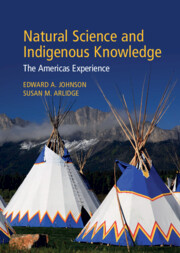161 results
Preface
-
- Book:
- Natural Science and Indigenous Knowledge
- Published online:
- 11 April 2024
- Print publication:
- 18 April 2024, pp xiii-xiv
-
- Chapter
- Export citation
1 - What Do Indigenous People Have to Tell Us about the Cultural Landscapes They Have Created?
-
-
- Book:
- Natural Science and Indigenous Knowledge
- Published online:
- 11 April 2024
- Print publication:
- 18 April 2024, pp 1-6
-
- Chapter
- Export citation
Index
-
- Book:
- Natural Science and Indigenous Knowledge
- Published online:
- 11 April 2024
- Print publication:
- 18 April 2024, pp 270-272
-
- Chapter
- Export citation
Contents
-
- Book:
- Natural Science and Indigenous Knowledge
- Published online:
- 11 April 2024
- Print publication:
- 18 April 2024, pp v-vi
-
- Chapter
- Export citation
Copyright page
-
- Book:
- Natural Science and Indigenous Knowledge
- Published online:
- 11 April 2024
- Print publication:
- 18 April 2024, pp iv-iv
-
- Chapter
- Export citation
Contributors
-
- Book:
- Natural Science and Indigenous Knowledge
- Published online:
- 11 April 2024
- Print publication:
- 18 April 2024, pp vii-xii
-
- Chapter
- Export citation

Natural Science and Indigenous Knowledge
- The Americas Experience
-
- Published online:
- 11 April 2024
- Print publication:
- 18 April 2024
Calorimetric Determination of the Enthalpies of Formation of Hydrotalcite-Like Solids and Their Use in the Geochemical Modeling of Metals in Natural Waters
-
- Journal:
- Clays and Clay Minerals / Volume 54 / Issue 4 / August 2006
- Published online by Cambridge University Press:
- 01 January 2024, pp. 409-417
-
- Article
- Export citation
4 - The Revolution and the Atlantic: The Society of the Friends of the Blacks
- from Part I - France
-
-
- Book:
- The Cambridge History of the Age of Atlantic Revolutions
- Published online:
- 18 October 2023
- Print publication:
- 09 November 2023, pp 118-142
-
- Chapter
- Export citation
The evolution of surface quasi-geostrophic modons on sloping topography
-
- Journal:
- Journal of Fluid Mechanics / Volume 970 / 10 September 2023
- Published online by Cambridge University Press:
- 29 August 2023, A10
-
- Article
-
- You have access
- Open access
- HTML
- Export citation
The genesis of metamorphosed Paleoproterozoic massive sulphide occurrences in central Colorado: geological, mineralogical and sulphur isotope constraints
-
- Journal:
- Geological Magazine / Volume 160 / Issue 7 / July 2023
- Published online by Cambridge University Press:
- 07 August 2023, pp. 1345-1375
-
- Article
-
- You have access
- Open access
- HTML
- Export citation
Particle-size segregation in self-channelized granular flows
-
- Journal:
- Journal of Fluid Mechanics / Volume 955 / 25 January 2023
- Published online by Cambridge University Press:
- 20 January 2023, A38
-
- Article
-
- You have access
- Open access
- HTML
- Export citation
Practice Variation between Salaried and Fee-for-Service Surgeons for Lumbar Surgery
-
- Journal:
- Canadian Journal of Neurological Sciences / Volume 50 / Issue 4 / July 2023
- Published online by Cambridge University Press:
- 16 June 2022, pp. 604-611
-
- Article
-
- You have access
- Open access
- HTML
- Export citation
Climatic controls on phosphorus concentrations in The Loch, Loch Vale Watershed, Rocky Mountain National Park, Colorado, USA since the last glacial maximum
-
- Journal:
- Quaternary Research / Volume 110 / November 2022
- Published online by Cambridge University Press:
- 26 May 2022, pp. 82-99
-
- Article
- Export citation
The propagation and decay of a coastal vortex on a shelf
-
- Journal:
- Journal of Fluid Mechanics / Volume 927 / 25 November 2021
- Published online by Cambridge University Press:
- 29 September 2021, A38
-
- Article
- Export citation
The decay of Hill's vortex in a rotating flow
-
- Journal:
- Journal of Fluid Mechanics / Volume 919 / 25 July 2021
- Published online by Cambridge University Press:
- 20 May 2021, A6
-
- Article
- Export citation
The decay of a dipolar vortex in a weakly dispersive environment
-
- Journal:
- Journal of Fluid Mechanics / Volume 917 / 25 June 2021
- Published online by Cambridge University Press:
- 28 April 2021, A35
-
- Article
- Export citation
Erosion-deposition dynamics and long distance propagation of granular avalanches
-
- Journal:
- Journal of Fluid Mechanics / Volume 915 / 25 May 2021
- Published online by Cambridge University Press:
- 09 March 2021, A9
-
- Article
-
- You have access
- Open access
- HTML
- Export citation
A distributed geospatial approach to describe community characteristics for multisite studies
-
- Journal:
- Journal of Clinical and Translational Science / Volume 5 / Issue 1 / 2021
- Published online by Cambridge University Press:
- 05 February 2021, e86
-
- Article
-
- You have access
- Open access
- HTML
- Export citation
The Qualitative Transparency Deliberations: Insights and Implications
-
- Journal:
- Perspectives on Politics / Volume 19 / Issue 1 / March 2021
- Published online by Cambridge University Press:
- 06 January 2021, pp. 171-208
- Print publication:
- March 2021
-
- Article
- Export citation




